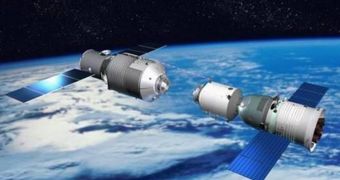Today, November 2, two Chinese spacecraft in low-Earth orbit will attempt to dock to each other, proving that the China National Space Administration (CNSA) can indeed start constructing its planned space station. The installation is scheduled to be completed by 2020.
The two unmanned cargo capsules – Tiangong-1 and Shenzhou 8 – launched about a month apart, on September 29 and November 1, respectively. The former was parked in an orbit that enabled it to wait the other's arrival.
Shenzhou 8 was launched directly on an intercept course. This is what allowed the capsule to approach its target so fast. The actual docking attempt will take place today, by EDT standards, or tomorrow, by local Chinese time, Space reports.
The probes were launched to space specifically to test docking technologies, which are at the core of constructing any type of multi-modular structure in space. If today's maneuver is successful, then China will have free terrain to set the other wheels of its long-term plan in motion.
What is interesting about the Chinese approach is that CNSA opted to conduct automatic docking tests before manual ones. This is a very ambitious plan, explains the editor of Aerospace International, Tim Robinson, as quoted by the Xinhua official news agency.
One of the reasons why this happened is probably because the Asian nation plans to reduce risks for its taikonauts. However, there are many things that can go wrong when such a complex maneuver is carried out using automated systems.
During the docking attempt, some of the commands the spacecraft will be fulfilling will be relayed by mission controllers on the ground. Still, most of the procedures will be carried autonomously by the unmanned space capsules.
According to Xinhua, the Shenzhou 8 spacecraft will be directed by mission controllers to within 50 kilometers (30 miles) of the Tiangong-1 vehicle. Once this mark is passed, autonomous guidance and docking systems will take over.
From that moment on, it will take about two and a half hours for the two spacecraft to come extremely close to each other. The actual docking process, where the two capsules make contact, will require 15 more minutes.
Before the end of 2012, CNSA will launch two additional Shenzhou missions, both of which will try to dock to Tiangong-1. The space agency announces that either Shenzhou 9 or Shenzhou 10 will be manned.

 14 DAY TRIAL //
14 DAY TRIAL //